Ultimate Plant Cage/Stake/Plant clip review
10 years ago planter, product review, trellis
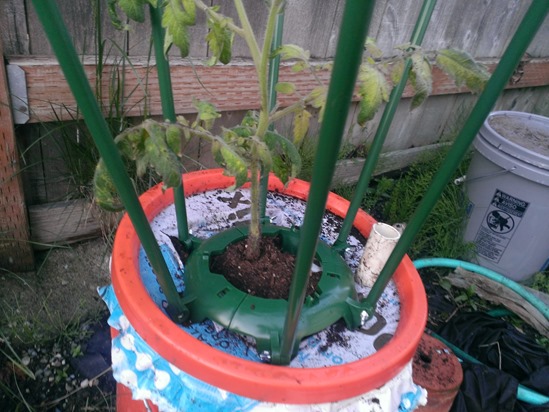
This nice people at Global Garden Friends were nice enough to send me a few of their product to try out with my garden this year and given today I was bringing out my cucumbers, tomatoes, zucchini, and pumpkins from the grow box it seemed like a great time to put them to the test.
The first product I tried out was their Ultimate Plant Cage which is a plastic ring that comes in four parts with spikes you can stab into the soil. I used this on my self watering planter which I just planted a tomato plant into today.
What I like about this system is you can actually assemble this around your plant which is helpful if you are a bit late adding a plant cage to your plants. Also on this right are six small posts which you can attach their Ultimate Plant Stakes (included with the kit) where you can adjust the height and the width as needed to support your growing plant.
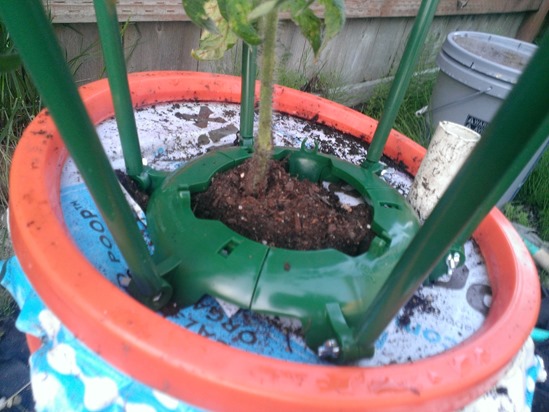
I also use a few more of their Ultimate Plant Stakes to give my peas a little help as they start to take off in the next couple weeks. The only complaint I have for these is there is not a lot of resistance when you extend these stakes so supporting from an angle may work ok but if your weight is a direct downward force I could see these potentially collapsing under some load.
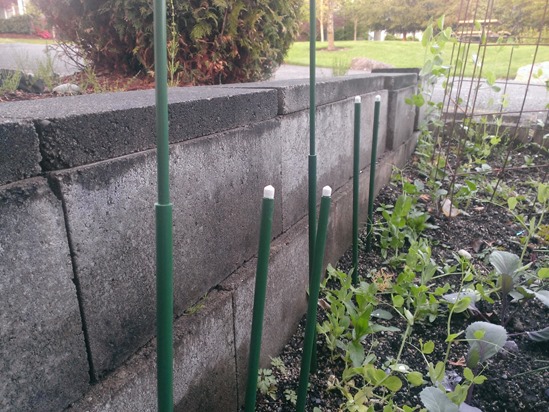
In addition they also sent me some plant clips which you can use to assist your vegetables to climb their trellis until they have adequate support on their own. I have done twine and zip ties in the past but what I like about these is they are much easier to remove when the time comes and also pretty large so easy to find to reuse on other plants as needed.

I suspect I will be able to use them to help my peas, tomatoes, and cucumbers find their trellises when the time comes.
Tags: re
New way to use egg cartons for starting seeds
10.2 years ago cheap, indoor seed starting, planter, seedling
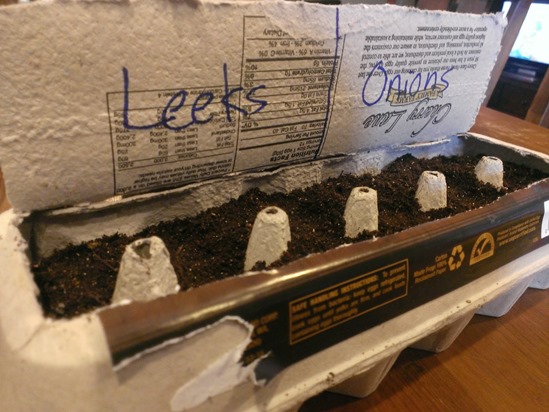
I have used egg cartons to plant seedlings before but here is a slight twist, instead of taking the whole lid off I cut the top off the lid. This not only gives you a neat place to label your seeds but more importantly, it provides an extra inch of depth for your seedlings to get a running start before being transplanted to your garden.
How To Make A Tire Planter
11.1 years ago cheap, container garden, DIY, guest post, planter, tires
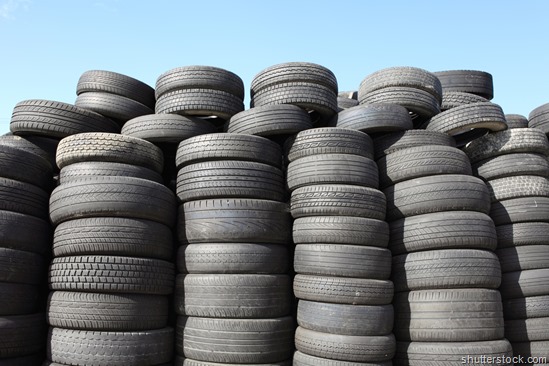
Used tires are a difficult waste product to dispose of as they take up a great deal of space and are discarded in large volumes every year. Through recycling a tire and turning it into a planter, you create something useful and attractive for your outside space for free and help the environment at the same time by keeping the tire out of landfill.
Try asking at your local garage or a breakers yard for unwanted tires, business owners are usually only too happy to give them to you as they normally have to pay to have them taken away. For this reason they are often dumped illegally by unscrupulous people.
If you want ‘how to’ videos then head for YouTube and you will find plenty but if you follow these step-by-step instructions then you will get the hang of this wonderfully simple and fun project in very little time.
First up you will need:
- An old tire or tires
- Box cutter knife
- Leather work gloves (for cutting)
- Chalk
- Paint (weather resistant)
- Soil & some compost
- Whatever you want to plant – flowers, vegetables etc
- Old clothes – tires are dirty!
- Elbow grease!
How to do it:
1. Find some used tires. Car tires are the easiest to get hold of and use for this, but if you have the space, you could use larger tires from a lorry or tractor. Create tall planters by stacking the tires to achieve the desired height.
2. Wash well with a degreaser and leave to dry. Old tires are usually quite oily and in need of a good scrub. This prepares the surface for painting and ensures adhesion.
3. (This step is optional). If you wish to open up the top of your tyre for extra planting space, remove one of the side walls using a sharp knife. With a little elbow grease and a very strong, sharp blade you can cut through and remove the side of the tire. Mark a guideline to follow using white chalk. Take care and wear a pair of leather gloves for added protection. If you will be stacking your tires, only cut the one that will be placed at the top, as the lower ones will need both sides in place to hold their shape. Lorry & tractor tires are much thicker so cutting them requires a powered grinder (or leave them as they are – much easier!)
4. Get creative! – Paint your tire using an oil based exterior (weather resistant) paint. Bright colors make a great impact in a contemporary space, or you could simply use white. If you are feeling adventurous though there is nothing to stop you painting polka dots, stripes, a pattern or whatever you like!
5. Leave the paint to dry fully. Have a rest!
6. Position your planter and fill it with soil and a bit of compost. Prepare for planting.
7. Plant up. Flowers, vegetables, herbs, strawberries, a tree or an architectural feature plant, the possibilities are endless. A stack of tires makes an excellent potato tower, as you can produce a large crop easily using minimal space. Once ready, simply knock your tower over and retrieve your crop. (You may wish to line your tire with plastic to prevent the possibility of any chemicals leaching into edible plants).
8. Sit back and enjoy your planter. Your new tire planter will last for years as it is made from an incredibly durable, weather resistant material. You have created something beautiful and practical and aside from your time and any paint you may have purchased, you project is both environmentally friendly, fun to make and free!
ABOUT THE AUTHOR
Felix is a member of the evergreenhedging.co.uk team. We are part of Greenshutters Nurseries & Garden Centre based near Taunton in Somerset which was established in 1980.
How to make a pea trellis tower
11.1 years ago cheap, peas, planter, tomato, trellis
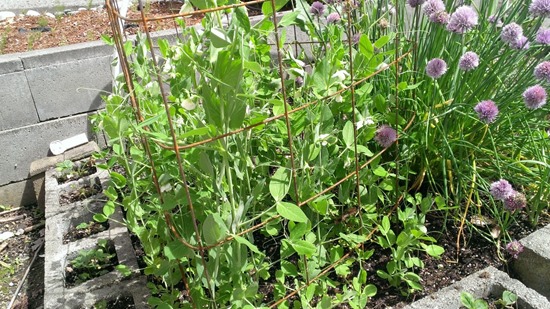
Long time readers know this is not the my first attempt at making a sturdy pea trellis I have had posts and posts about this in the past. Though those creations were a bit cheaper than my current version this one will not be falling down no matter how big those plants get.
First I started with a 4 foot by 8 foot cattle panel which ran me about $6 at Home Depot.

Given the panel had sharp edges and my largest vehicle is a pretty new minivan with leather seats I planned ahead and started the construction in the Home Depot parking lot. Taking a piece of scrap lumber I placed it on the 5th cross section on one side and bent it up until it was perpendicular to the ground then repeated with the other side.

The I carefully placed the bent panel into my minivan and brought it home for the remaining construction which pretty much was adding a zip tie in the middle to make a isosceles triangle and then tucked both ends to interweave with the other open side of the tower.

Next I used some pliers to not have as many sharp pointy parts for my kids…probably more likely me to poke myself with and also filed down any ends that seemed overly sharp.

So I had a bit of a strategy for planting the peas, to know where to plant I placed my tower in the desired spot and wiggles it around to make and outline to plant my peas. I removed it as you can see below and planted two rows of peas inside the perimeter. Then in a few weeks I will plant peas on the outside of the tower. The idea is the peas will grow and climb up the tower and have sunlight and adequate airflow to thrive. Then the second crop will start to grow but by the time it starts to disturb the inside crop they will already be harvested.

I also planted peas on the outside of the tower now on the northern facing side of the tower since it wouldn’t get much sunlight after the interior had a head start.

I know a few of you are probably thinking, “Wow this is awesome for peas, but I bet this would make an real sturdy tomato tower and way better than the ones I can buy in the garden center.” Which I would have to agree with you on that one large enough to provide good airflow and sturdy enough to support and fairly large tomato plant.

Tips to choose plants for indoor gardening
11.1 years ago guest post, planter

Indoor gardening is one of the best ways to decorate your home. These are simple to maintain provided you give a good amount of attention and care to the indoor plants. Even people having limited space could work wonders and end up getting a rewarding experience. Choosing the right set of plants for your indoor garden could give you some of the best enjoying experience. However, choosing these plants for your indoor garden for your home or office is always a complex affair. At times, even the people from the nursery staff are seen struggling for choosing the plants if you fail to give the right picture of indoor garden or the things you want in the garden. If you select wrong plants for your indoor garden, you may end up creating a mess at your space. Hence it is always recommended to research about the same. The below is the list of helpful tips to choose proper plants for your indoor gardening mission. Let’s check them out:
Check your space size
There are number of plants fit for indoor gardening but each one has its own space requirement. Hence before you choose any check its exact space requirements. Select the right plant for your space, which you are supposed to be filled. Always keep in mind that most of the indoor space doesn’t need any light for plants to blossom and that the flowering the plants and the ones having the variegated leaves simply need higher amounts of light levels as compared to the other plants. The plants, which are seen doing good with the full or partial amount of shade are best suited to live inside the gardens and can move anywhere inside your home or office.
Consider the weather conditions
Another factor that you need to consider is the weather conditions. You are supposed to select a plant as per the weather conditions you have at your space and its surroundings. If you choose flowering plants then make sure you understand very well that these require good amount of light levels but the plants including the gorgeous Phalaenopsis orchid are seen doing good at spaces where you have high humidity levels like the bathrooms and kitchens. Also, the Phalaenopsis orchid does not require direct sunlight or being placed over any draft, hence the areas that are overly air conditioned are certainly not the appropriate for such delicate kinds of plants.
Check the size
Once you have considered the above two factors, it’s time to consider the element of size. The small size flowering plants including the bamboo and cacti could be a good option for placing them over the coffee table or at the spaces with limited amount of space. The herbs are often considered as the ideal option for small size window boxes and palms including thatch palm or the love palm plants. These appear good in the different free standing pots seen over your room’s corner wherein you want to put some little larger plant.
Consider the factor of time
While choosing plants, you need to consider your attentiveness and active participation time as well. The evergreen and Cacti plants would hardly require any effort whereas the violets and several other exotic plants are called as temperamental and demanding in terms of time. Avoid going for a plant, which demands careful controlled amount of water feeding when you know you hardly have time to do so where there is a possibility of forgetting to the feet the water as well. The fact is, most of the indoor plants die down due to over watering hence you are supposed to check the moisture levels of the soil before you start watering your plants abruptly. This will help you in preventing things like the water logging. If you use the sub irrigation over the decorative pots, then make sure the plants would require more amount of water at the roots.
Know the good performing indoor plant options
There is a wide range of indoor plants, which you could choose for your indoor garden. A few of these could be chosen as per the above considerations, while there are few specific high performing indoor plants. These plants could be planted inside any and every indoor garden as they are among the high performing plants. These include Cast iron plant, Dragon tree, Love Palm, Thatch Palm, Hearth Leaf Philodendron, Devil’s Ivy, Mahogany tree, Peace lily, Aroid palm and Mother in law’s Tongue.
Final word
A good array of plants inside your indoor garden could do wonders provided you choose the right amount of plants for your space. However, choosing your indoor plants for your indoor space is always a complicated thing. When it comes to choosing them, consider the above tips.
About The Author: Alia is a writer/blogger. She loves writing travelling and reading books. She contributes to Gamification
How to construct a raised vegetable garden
11.2 years ago guest post, outdoor seed starting, planter, vegetable bad
If you have a messy child who loves to plant and play around the garden, but who you are fed up of cleaning up after a day of joyful dirty exploration, a raised garden bed may be the ideal solution you are so deeply looking for. This type of bed is easy enough to build, takes around 2 hours to build from start to finish, and will set you back by around $200 – $300.

Recommended materials
Although you could use pretty much any type of wood you wish to make the bed, it is recommended that you use some form of rot-resistant wood, which isn’t coated in anything which may be harmful if eaten; after all, you are about to plant vegetables in it, and we all know how much children love to put anything and everything into their mouths. Next, you need to select your plot of ground. Ideally it will be somewhere with plenty light, and a maximum of 4ft wide, so that the children can reach into the middle without climbing or falling into it, however it can be as long as your elected choice of timber allows. For the best drainage, you should remove the grass on your elected plot, and tile it under the soil. The following set of instructions will allow you to make a bed 4ft wide by 10ft long, but you can change the values to suit your needs.
The frame
Firstly, you should cut an 8ft length of your elected timber in half, to create your 2 4ft ends. Hold one of your 10ft lengths on its end, and line up one of your 4ft cuts so that the face of your 10ft length covers the cut end of your 4ft length. Using a drill or screwdriver, attach the two pieces together through the back of the 10ft board, and into the cut end of the 4ft length. It is advisable to use 3 x 3” screws, but you can essentially use as many as you wish to ensure it is sturdy. Do the same thing for all sides, so you should now have the outline of your bed in a basic rectangle shape. Once all the sides are attached, use a framing square to ensure all the corners sit at a 90 degree angle, and adjust where necessary.
Corner support
Now that you have your bed in a perfect rectangle, you want to keep it that way. So attach a piece of wood to each corner, which should give you a triangle shape at each of your corners. Again, attach these pieces with as many screws as you feel necessary.

Select your spot
Now you can move your frame to your elected sunny spot, and mark out where it will lie by drawing a line around the outside of your frame with a shovel or spade.

Preparing the ground
Now you know where your bed is going to sit, take the frame out of the way again, and remove the grass layer where your bed is going to sit. After you have removed the grass, try to turn the soil a bit so that you will have good drainage.
Making sure all is level
Lift your frame back into its final sunny resting place, and remove soil from around the edges of the frame so that all sides are level with one another.
Secure your frame
The next step involved settling your frame into place, to ensure it doesn’t move. You should cut 10 2ft lengths of wood, and create a spike at one end by cutting diagonally from around 5” up the long side, into the middle of the short side on both sides. Once you have make all of your stakes, hammer them at least 18” into the ground, and 2.5ft intervals along the outside of the long edges of your frame. Once they are in the ground, secure your stakes by drilling through them and the frame of the bed so that they are 100% in place. Then put a stake into each corner, and secure the same way. Finally, you need to put one stake into the middle of each short edge, but only secure with screws on one side.

Adding your soil
You can now remove the unscrewed edge of your bed, and use your wheelbarrow to empty a combination of soil and compost to fill the bed until the soil sits around 2-3” from the top edge of the frame.
Complete your frame
You can now put the short edge of your frame back into place, and secure with screws like you did with all of the other sides. As a finishing touch to your masterpiece, you can use a saw to cut the top of all of the stakes so that they sit level with the rest of the frame.

Let the fun begin!
Now that your bed is completed, you can begin to plant your vegetables and plants. Just remember to keep them well watered, and you’ll be eating home-grown vegetable soup in no time at all!
Author Bio: Peter Smith loves gardening at his free time. He also gives online gardening tips to people, click here to go to his site. Apart he is an experienced freelance writer.


